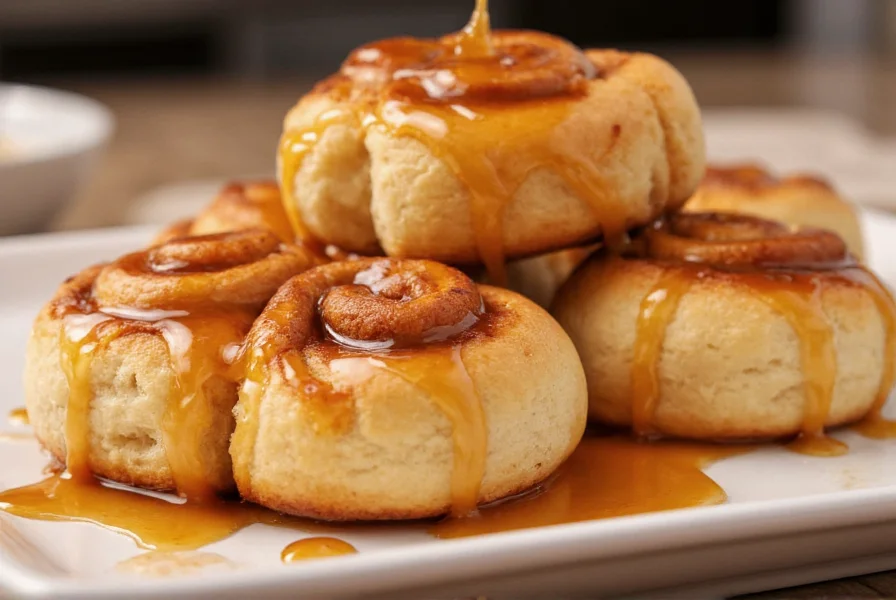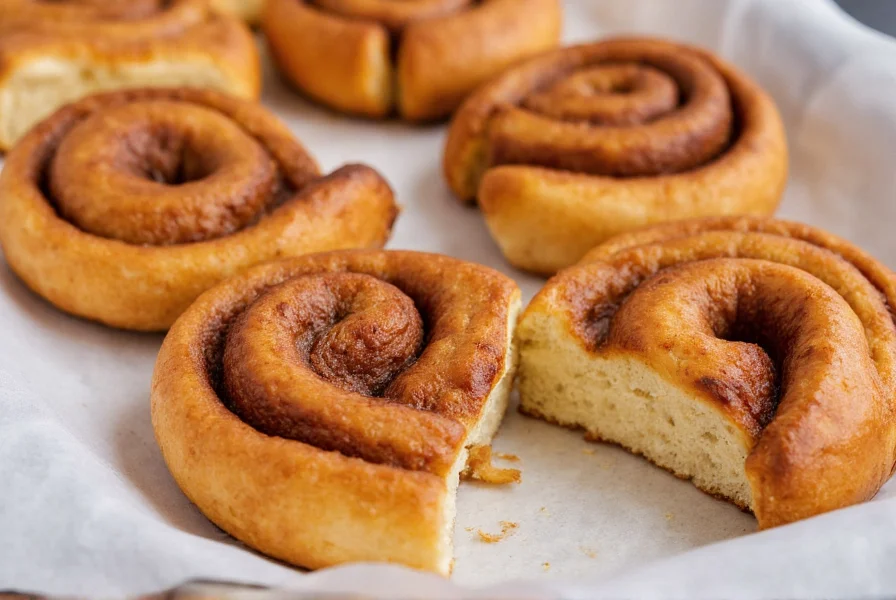When perfectly executed, sticky cinnamon scrolls deliver a harmonious balance of fluffy yeast dough, aromatic cinnamon filling, and that signature sticky-sweet bottom layer. The magic happens through a specific baking technique where the rolls are placed on top of a melted butter, brown sugar, and syrup mixture that transforms into a caramelized sauce during baking.
The Science Behind the Stickiness
What truly differentiates sticky cinnamon scrolls from standard cinnamon rolls is the baking method and sauce composition. Traditional cinnamon rolls are typically topped with icing after baking, while sticky scrolls incorporate the sweetness before baking through a carefully balanced sauce that penetrates the dough.
The key components that create that irresistible stickiness include:
- Brown sugar - Provides molasses content that creates the caramelized texture
- Butter - Adds richness and helps the sugar mixture melt properly
- Corn syrup or honey - Prevents crystallization and enhances the sticky texture
- Proper baking temperature - Ensures the sauce bubbles through the rolls without burning
| Ingredient | Traditional Cinnamon Rolls | Sticky Cinnamon Scrolls |
|---|---|---|
| Sweetener Base | White sugar in filling | Brown sugar + corn syrup/honey sauce |
| Baking Method | Right side up | Upside down on sauce |
| Final Texture | Dryer bottom, icing on top | Uniformly moist, sticky throughout |
| Serving Temperature | Best warm | Must be served warm to maintain stickiness |
Essential Ingredients for Perfect Sticky Cinnamon Scrolls
The quality of your ingredients directly impacts the final product. For authentic sticky cinnamon scrolls that maintain their texture and flavor:
Dough Components
Use bread flour rather than all-purpose for better structure. The higher protein content creates a chewier texture that holds up to the sticky sauce. Fresh yeast produces superior flavor compared to instant, though both work. Whole milk (not skim) provides necessary fat content for richness.
Filling Secrets
The cinnamon-to-sugar ratio is critical—aim for 2-3 tablespoons of high-quality cinnamon per cup of sugar. Vietnamese or Saigon cinnamon delivers more intense flavor than common Cassia varieties. Adding a touch of espresso powder enhances the cinnamon notes without making the rolls taste like coffee.

Step-by-Step Preparation Guide
Follow these professional techniques to achieve bakery-quality sticky cinnamon scrolls at home:
Preparing the Sticky Base
Melt 1 cup (225g) unsalted butter with 2 cups (400g) packed dark brown sugar, 1/2 cup (120ml) light corn syrup, and 1/4 teaspoon salt in a 9x13 inch baking pan over medium heat. Stir constantly until the mixture bubbles and the sugar dissolves completely (about 5 minutes). Remove from heat and let cool slightly while preparing the rolls.
Dough Rolling Technique
Roll your prepared dough into a 16x24 inch rectangle. The ideal thickness is 1/4 inch—too thick and the rolls won't cook through properly, too thin and they'll become dense. Spread softened butter (not melted) evenly across the surface before applying the cinnamon-sugar mixture. This creates a barrier that prevents the sugar from sinking into the dough.
Rolling and Slicing Precision
Roll the dough tightly from the long side, using a bench scraper to help lift and tighten as you go. When slicing, use a sharp serrated knife or dental floss for clean cuts without compressing the rolls. Aim for 1.5-inch slices—wider cuts create more impressive individual rolls but require slightly longer baking time.

Common Mistakes That Ruin Sticky Cinnamon Scrolls
Even experienced bakers encounter issues with sticky cinnamon scrolls. Understanding these pitfalls ensures success:
- Incorrect pan temperature - Pouring rolls onto boiling hot caramel causes immediate setting, preventing proper absorption. The sauce should be warm but not bubbling vigorously.
- Over-proofing the dough - Rolls that have risen too much before baking will collapse when placed on the sauce, losing their defined shape.
- Improper inversion timing - Waiting too long to flip the pan after baking causes the scrolls to stick permanently to the pan. Ten minutes is the critical window.
- Using low-fat dairy - Skim milk or low-fat butter creates a less rich final product that doesn't carry the caramel flavors effectively.
Storage and Reheating for Optimal Stickiness
Sticky cinnamon scrolls are best enjoyed fresh, but proper storage maintains quality:
Store cooled scrolls in an airtight container with parchment between layers for up to 2 days at room temperature. For longer storage, freeze individual rolls on a baking sheet, then transfer to freezer bags. To restore that fresh-baked stickiness:
- Thaw frozen scrolls overnight in the refrigerator
- Place on a baking sheet and cover with foil
- Warm in a 300°F (150°C) oven for 10-15 minutes
- For immediate stickiness, microwave individual scrolls for 15 seconds
Avoid conventional reheating methods like toaster ovens which dry out the delicate dough. The microwave method actually preserves moisture better for this particular pastry.
Creative Variations Worth Trying
Once you've mastered the classic sticky cinnamon scroll, experiment with these professional variations:
- Nutty Delight - Press chopped pecans or walnuts into the sticky base before adding the rolls
- Apple Cinnamon - Layer thin apple slices over the caramel before placing rolls
- Cheesecake Swirl - Pipe small dollops of cream cheese filling between the cinnamon layers
- Maple Bourbon - Replace corn syrup with pure maple syrup and add 2 tablespoons bourbon to the base
FAQs About Sticky Cinnamon Scrolls
Why are my cinnamon scrolls not sticky?
Your cinnamon scrolls likely aren't sticky because of insufficient corn syrup or honey in the base mixture, incorrect baking temperature, or not allowing proper cooling time before inversion. The ideal sticky base requires a precise ratio of 1 part corn syrup to 4 parts brown sugar. Baking at too high a temperature causes the sugar to crystallize rather than caramelize. Always let the scrolls rest for exactly 10 minutes after baking before flipping—the timing is critical for the sauce to properly absorb into the rolls.
How do sticky cinnamon scrolls differ from regular cinnamon rolls?
Sticky cinnamon scrolls bake upside down on a caramel base that soaks into the dough during baking, creating uniform stickiness throughout. Regular cinnamon rolls bake right-side up with dry bottoms and receive icing only on top after baking. The sticky version uses a pre-bake sauce of brown sugar, butter and corn syrup, while traditional rolls rely on post-bake icing. Sticky scrolls have a moister texture overall and must be served warm to maintain their characteristic stickiness.
Can I make sticky cinnamon scrolls ahead of time?
Yes, you can prepare sticky cinnamon scrolls in advance using the refrigerator method. Assemble the rolls on the caramel base, cover tightly, and refrigerate overnight. When ready to bake, remove from refrigerator 30 minutes before baking to take the chill off, then bake as directed—adding 5-7 minutes to the baking time. Do not prepare the caramel base more than 24 hours ahead as the sugar mixture may crystallize. For best results, bake and invert the scrolls the same day you plan to serve them.
What's the secret to preventing sticky cinnamon scrolls from sticking to the pan?
The key to preventing sticking is proper pan preparation and timing. Use a light-colored metal pan (not dark non-stick), generously coat with butter before adding the caramel mixture, and ensure the caramel has cooled slightly (to about 180°F/82°C) before placing the rolls on top. Most importantly, invert the pan exactly 10 minutes after removing from the oven—any sooner and the caramel won't have set enough, any later and it will harden too much. Running a thin knife around the edges before inverting also helps release the scrolls cleanly.











 浙公网安备
33010002000092号
浙公网安备
33010002000092号 浙B2-20120091-4
浙B2-20120091-4